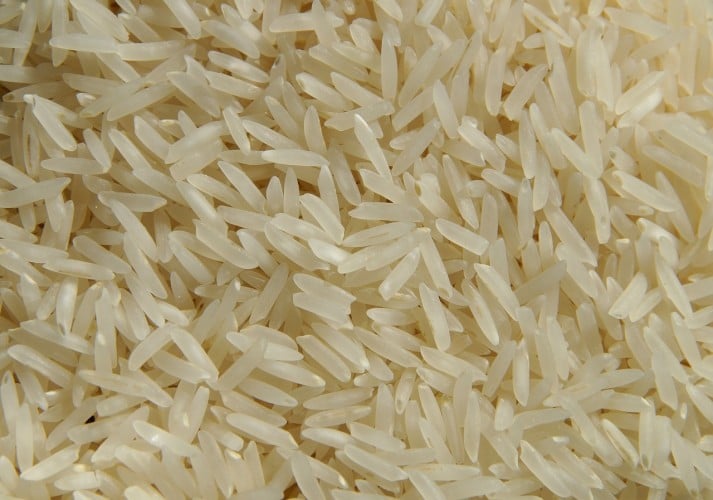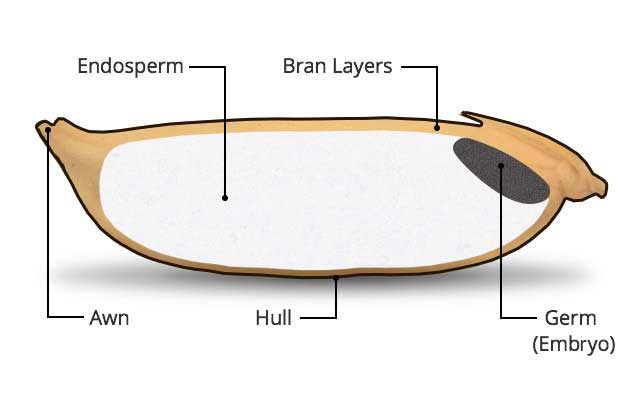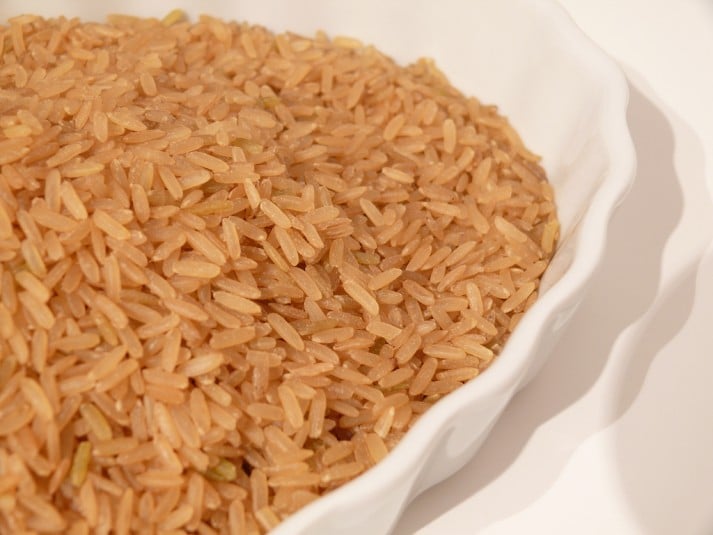This
post was originally published on
this siteOriginally posted at: http://www.nerdfitness.com/
I wanted to know the exact answer to the age old question, “What’s the meaning of life?”
But I couldn’t find an answer for that. So instead I set my sights on rice:
- Is it good for us? Bad for us?
- How do different types of rice affect me?
- What wins, brown rice vs white rice?
- Did Mitch Hedberg ever make it onto a Rice Krispies box? RIP.
After all, we get questions about rice ALL the time:
“Steve I’m Paleo but I hear rice isn’t that bad for you, help?”
“Why do you eat white rice at Chipotle? I hear white rice is way worse for you than brown rice. Just like white vs wheat bread!”
“Is it okay to eat rice and not anger the Paleo Gods?”
Let’s unlock this mystery of the universe.
Is Rice Healthy For Me?

Depending on how you want to feel about rice, you can point to either of the following studies:
People that live in Okinawa (home to Mr. Miyagi!), the highest life expectancy on the planet, eat a lot of rice. Rice HAS to be good for you then. Team Rice!
People of the Marshall Islands, home to one of the highest rates of Type 2 diabetes (pdf) on the planet, eat a lot of rice. Rice is the devil! Team No Rice!
Feel free to pick one of the above studies to show that you’re right and superior compared to the other team. It’s like opposing political parties (rice vs no rice) that staunchly follow party lines.
Now, if you have’t made up your mind on rice (you’re an independent!), or you’ve been avoiding it because, Paleo, keep reading. Or maybe you’re up for, gasp, changing parties!
Let’s dig into this election! Feel free to listen to “Hail to the Chief (but just the part you know)” while reading the rest of this.
Rice is technically is a seed of the grass species. It comes in many varieties, it’s a grain that doesn’t contain gluten (unlike some other grains), and its macronutrient breakdown is generally something like (in 1 cup of cooked rice):
- 200ish calories
- 0-1 gram of fat
- 45ish g of carbohydrates
- 4-5 grams of protein
Now, depending on how you currently view your diet, you might have a few key thoughts looking at that list above. “45 grams of carbs! That’s bad! Carbs are bad because I read it somewhere! Rice? Ah!”
The reality is this: carbs are neither inherently good nor bad. Kind of like The Force in Star Wars; the Force can be used for good or evil purposes, but it’s inherently neutral: quantity and quality matter.
Rice can be part of a bad (unhealthy) or good (healthy) diet completely dependent upon your goals and lifestyle:
- Are you in the process of building muscle and getting bigger? Rice is a cheap source of high calorie, high-carbohydrate food, easily digestible and helpful in running a caloric surplus.
- Trying to lose weight? You might be trying to lose weight and find that eating a lot of rice is putting you over your calorie and carb goals for the day, so you may choose to eat less or avoid the food entirely.
At the end of the day, consuming more calories than you burn will add weight to your frame in the long term, and vice versa: this is Food Science 101, and it will be on your midterm exam.
Now, obviously it’s not the whole story (quality and type of calories are important too). There’s a lot going on behind the scenes with rice.
What’s the Difference Between Brown Rice and White Rice?

“Does getting white rice at Chipotle instead of brown rice make me a bad person? Everybody tells me brown rice is better!”
There’s a prevailing thought in society that eating the brown option of a food is better than the white option: “eat wheat bread instead of white bread, whole wheat pasta instead of regular pasta, eat brown rice instead of white rice.”
Like most things, this sentiment has been oversimplified to the point of being unhelpful. What you really want to know is this:
If this was a rice presidential election – a Rice-idential election, if you will, who should I vote for?
Let’s start here: what makes white rice white and brown rice brown, other than color? It all depends on the milling process. You can see here highlighted by Riceland, which is less fun than Disneyland but probably safer than Zombieland:

In milling, brown rice loses only a bit of the top layer above; the non-edible hull goes, but the bran and germ remain. White rice removes it all; the hull, awn, bran and berm are all gone, leaving behind the endosperm.
So let’s take a look at our two candidates for the Rice-idency: On one side of the ballot, we have 1 cup of cooked enriched white rice, and on the other side we have 1 cup of cooked brown rice.
They both are running on the platform of “Make carbs great again!” but they have some distinguishing characteristics that make their campaigns slightly different:
- Brown rice has 43 more calories per cup than white rice.
- Brown rice has 7g more carbohydrates per cup than white rice.
- Brown rice has more micronutrients: magnesium (79mg vs 19mg), more phosphorus (208mg vs 68gm), and more potassium (174mg vs 55). It also has a lot of manganese, selenium, and copper.
- Brown rice has a lower glycemic index than white rice, meaning it is broken down by your body slower – and causes a lower insulin response.
Now, you’re looking at those things above and probably thinking: “Okay so brown rice has more calories and carbs, that’s bad and I don’t want to vote for that candidate! Wait, it has more micronutrients, and a lower glycemic index. I think that’s good and I should vote for that candidate.”
And then your head explodes.
Like any election, there are positives and negatives to either candidate, and as you’ll see soon enough – neither one is an angel. In this election, the differences in nutritional terms is negligible from the highest macro-level (aka the big policy points). So from a purely caloric and macro-nutrition standpoint, we recommend simply letting your tastebuds decide if you choose to vote:
- If you like the taste of brown rice more than white rice, eat that.
- If you like the taste of white rice more than brown rice, eat that.
Done. I’m going on break (for those counting at home, that’s 2 Mitch references in an article on rice).
That’s the simplified way of looking at it. If one digs into the nitty-gritty of both campaigns, we’ll discover that there’s more than meets the eye.
Like Transformers.
White vs Brown Rice: our Recommendation

For those wanting to nerd out, welcome to the full coverage of the 2016 Rice-idential elections!
Our candidate Brown Rice is running on a platform of more micronutrients for every citizen, something White Rice can’t claim.
However, like any campaign, the whole truth isn’t being represented. In fact, my research led me to believe that there are two key problems with Brown Rice that keep me from casting my vote for Brown.
You see, brown rice contains something called Phytate, an anti-nutrient that minimizes our body’s ability to absorb the beneficial nutrients. Phytate (phytic acid) is found in most seeds, legumes, nuts, and grains…including rice.
Phytic acid is contained in the part that’s removed from white rice. So brown rice has it, and white rice doesn’t. This is when White Rice comes in to say “I don’t have any of this stuff, vote for me!”
On top of that, because White Rice is enriched, it closes a lot of the gap between micronutrients, and because there’s no phytates around, these nutrients can be fully absorbed by the body. In the end, White Rice has a pretty good argument that it’s stronger on the “micronutrient issue.”
As this pub med study explains, results show that “despite higher nutrients contents of brown rice compared to white rice, experimental datas does not provide evidence that the brown rice diet is better than the diet based on white rice.”
Or, as Alan Argon summarizes: “White rice actually has an equal or better nutritional yield & also has a better nitrogen-retentive effect than brown rice. This is because the fiber & phytate content of brown rice act as antinutrients, reducing the bioavailability of the micronutrients it contains.”
So, does this mean we should proudly cast our ballot for White Rice?
In our hours and hours of research, chats, hangouts, and debates that went into creating this article, we stumbled across some troubling news for both candidates’ campaigns for the Rice-idency: a history of arsenic and a possible diabetes scandal!
(feel free to audibly gasp at this point; we encourage it)
Rice, Arsenic, and Diabetes

We head out to the debate in which the candidates are fielding questions from regular folks (with totally not staged questions).
Mike, a retired teacher and single parent from Vermont asks, “I heard about rice and arsenic – should I be concerned?”
Arsenic is a metalloid, and extremely small qualities of “organic arsenic” is essential as a dietary element. However, inorganic arsenic (from rocks and soil) is a different thing – and this is the stuff that causes poisoning in large enough quantities. Typically we’re only concerned with this if the exposure is a lot over a short term, or a little over a long term. So with rice, it starts to become more and more relevant if you are eating rice “every day for years and years.”
The catch is, for millions around the globe, this situation is a reality.
As Authority Nutrition points out, in the long term, taking in too much (inorganic) arsenic has been linked to all sorts of problems: cancer [2] [3] [4], vascular disease, high blood pressure, heart disease, and diabetes. In short, over time (if we’re consuming a moderate amounts regularly), arsenic can act like a slow poison to our bodies.
AND here comes White Rice to respond with a vicious attack:
“Consumer Reports found that Brown Rice has 80% more arsenic on average than white rice of the same type!”
Our moderators are telling us this is a crucial turning point towards a White Rice victory.
(There are all sorts of differences in arsenic amounts among brands, types of grains, and even how you prepare your food. If this is important to you, be sure to click on over and read more.)
Suzy, a happily-married steel worker from Ohio asks, “What about diabetes, I heard that is an issue with rice!”
It’s here that Brown Rice steps up and starts slinging some mud as well. The candidate proudly proclaims, “ignore that negative nonsense about my arsenic count, White Rice gives you diabetes! ISN’T THAT RIGHT WHITE RICE!?”
Oh snap.
This meta analysis found that “higher white rice intake is associated with a significantly elevated risk of type 2 diabetes, especially among Asian populations… In addition, the dose-response relations indicate that even for Western populations with typically low intake levels, relatively high white rice consumption may still modestly increase risk of diabetes.”
Now if you’re watching this debate at home, you’re probably asking, “I’m in the “at risk for type-2 diabetes” group, would swapping out white rice for brown rice improve my future?”
Researchers found in an observational study that people who consumed five or more servings of white rice per week had a 17% increased risk of diabetes, compared to people who ate less than one serving per month. But eating two or more servings of brown rice per week was associated with an 11% reduced risk of developing type 2 diabetes, compared to eating less than one serving of brown rice per month. Fitness Skeptics, be sure to look closely at this one.
Either way, in true election fashion, we now have two imperfect candidates.
So, who the heck do you vote for!?
Steve, Just tell Me Who to Vote FOr.

This is Steve Kamb, reporting live from Nerd Fitness News, and we feel confident enough to make our endorsement in the Race for the Rice-idency.
This campaign has been ugly as hell; both candidates are running on a very similar “Rice is great” platform, which we have no problem with (in moderation). Let’s break it down for voters out there:
Again, our official recommendation is to vote for whatever candidate you think tastes better (okay, our metaphor might be breaking down at this point). But for those of you at home who want to make the most informed decision as possible or are concerned about a specific health issue, here’s our detailed recap:
Here’s our official recommendation:
- Rice can be a healthy part of a diet, but it’s the rest of it that will determine if you’re healthy or not.
- Not eating rice is fine too, provided you’re eating some sort of healthy starch/carb source (we love veggies!).
- We feel that for most people, you should pick what you like best and eat it. Done! If we had to pick one generalization in our nerdy, non-doctor opinion, we would guestimate that white rice is (only slightly) better option for most people, due to the phytate and arsenic levels in brown rice.
- If you are eating lots of rice or other arsenic containing foods regularly over a long period of time, consider white rice, looking at specific brands, and preparation methods to mitigate these risks.
- If you are struggling with weight and or a sedentary lifestyle and thus concerned with diabetes, consider brown rice in moderation over other unhealthy foods. Don’t delude yourself into thinking you’re being healthy by eating buckets of brown rice though. Clyde Wilson, Ph.D, a nutrition professor in the Stanford University and University of California, San Francisco schools of medicine, puts it succinctly: “The reality is that eating too much of any carbohydrate, including brown rice, can lead to diabetes.”
No matter what candidate you vote for, we urge you not to get WHITE RICE or BROWN RICE tattooed on your forehead, giving yourself a green light to eat 1,000s of calories of it (rice, fruit, anything!). Moderation, as always, is a boring lesson that we urge voters to be mindful of.
TL;DR #50 – Eat rice in moderation if you choose to eat it. If you are bulking up intentionally, rice can be a great part of your diet. Trying to lose weight? Consider minimizing rice consumption. If you’re gonna eat rice regularly, white rice is probably healthy for you in the long run. If you are a type-2 diabetic (or at risk), minimize consumption of grains and carbs, but IF you do eat rice, go for brown rice.
Tune in after this commercial break where we’ll answer the question: is the monster under your bed trying to kill you? The answer may shock you!
-Steve
###
photo: Colin Kinner: Question Mark, Arria Belli: Brown Rice, Al Case: Rice Field







 For today’s edition of
For today’s edition of 











 For now classes are 6pm and 640pm at 2840 Wildwood st in the Boise Cloggers studio.
Book your class NOW!
click this ==>
For now classes are 6pm and 640pm at 2840 Wildwood st in the Boise Cloggers studio.
Book your class NOW!
click this ==>








